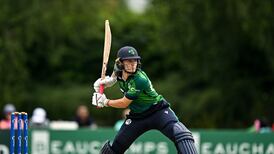What was performance analysis like in Pat Lam's playing days? "We'd probably just sit in the bar talking about the game," the Connacht coach told an RDS audience earlier this month. "It started to be introduced once we hit professionalism but it was nowhere near as detailed as it is now."
Last summer the LA Lakers hired a liaison to sit between their analysts and coaching staff. To manage the pipeline of ideas, apparently. One could view such an appointment in a number of ways – were the analysts generating so many bursts of number-driven genius that the coaching staff were overwhelmed? Or did the coaching staff need somebody to sit between the two, translating numbers into coach-speak?
Whatever one’s view, there is one core truth: all the analysis in the world isn’t worth a damn if it doesn’t get translated into something useful on the pitch, the training paddock or player scouting.
At the Web Summit earlier this month the Connacht coach talked about the use of data and analysis in the coaching set-up, and Lam took some time later to chat with The Irish Times.
The former Samoan international said that while at Auckland he'd learned how to code his own match video. Then to Connacht, where the resident analyst had the same software. "I arrived and I said, 'great, where's mine?'"
There was no software budget for Lam, and he found his analyst working in a cell. “Honestly. In a room. Solid brick. Just like a jail cell. And three or four players all bunched in.”
Funding increase
Lam said he told the analyst to tell him exactly what his department had, and then to compare it to Ulster, Munster and Leinster. Lam said he then went to the Connacht board and the IRFU to get a funding increase to level the playing field.
That analyst was Conor McPhillips, now part of Lam’s coaching team.
“The first year Pat came, he was used to what he had in Auckland” said McPhillips. “There had to be a big investment in software, editing licences, cameras, more laptops, endzone masts.”
Lam’s analysis budget now resembles that of the other Irish provinces. These things cost money, but Lam considers it worthwhile “because it brings the perception of players of their performance and the reality closer together”.
As well as heading up the analysis department, McPhillips is now assistant attack coach. He spends more time on the pitch but he might not be there at all today had he not been under contract when Lam arrived. “He told me straight up – if he’d had his way he would have brought his Auckland analyst with him, because that trust had been built. And I completely understand that.”
The relationship between a coach and his analyst can be tight. "When Matt Williams went from Leinster to Scotland, he brought Brett Igoe with him, who was the Leinster analyst," said McPhillips, who has built a good relationship with Lam.
“Coaches have their groups that they trust, and if they go somewhere they often like to go as a package.”
Igoe is now programme director of the MSc in sports performance analysis at IT Carlow. “I am always interested when high-profile coaches move clubs that the analyst seems to come,” said Igoe, who said they work on the communication and presentation skills of the analysts on the course.
Data and video
Munster’s head performance analyst George Murray said that the data aspect of the role had increased. “Data and video is mainstream now. When I started 15 years ago it was all video, not much data. Now it’s about 60/40 video to data, in general.”
He said data can be used to identify areas that might not be seen on video. “Data’s very powerful for identifying trends over time, within yourself retrospectively or in advance of previewing an opposition.”
Knowing how to then present that data to coaches and players is important, and Murray said he avoids simply presenting a list of numbers.
“I summarise it to complement what we see on the video”, said Murray. “It could be the top performers; it could be a facet of their game that’s weak. It helps us to put some things up in a red light.”
Like Munster, Connacht work with Opta’s feeds alongside their own data, applying their own analysis to assist in comparisons over time between themselves and other sides. McPhillips said that while they wouldn’t always agree with Opta’s parameters, they at least know they are applied consistently across teams.
“There’s a saying that the only sustainable competitive advantage you have is the ability to learn faster than the opposition,” said Lam.
He considers performance analysis to be a big part of that, and the effort expended on it should be treated preciously.
“One of the things that I’ve told Conor and his team is to make sure that, whatever you’re doing, if I’m not using it, you challenge me. Because then we’re just wasting our time.”











